If you’re battling mouth sores, gum irritation, or minor oral wounds, Colgate Peroxyl Mouth Sore Rinse is a game-changer you need in your bathroom cabinet. This alcohol-free, hydrogen peroxide-powered rinse soothes, cleanses, and speeds up healing with a gentle minty kick.
Trust me, it’s a must-have for anyone seeking fast relief and a fresher mouth. In this article, I’ll share my personal experience, break down the pros and cons, offer maintenance tips, compare it to other brands, and answer your burning questions.
Ready?
Let’s explore why Peroxyl deserves a spot in your routine!
My Experience With Colgate Peroxyl
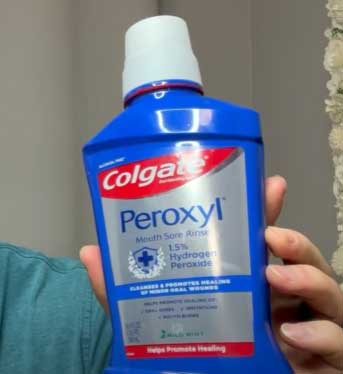
I’ll be honest—mouth sores are the worst.
A few months ago, I bit my cheek during a rushed lunch, and what started as a tiny annoyance turned into a throbbing canker sore that made eating and talking a chore.
Desperate for relief, I stumbled across Colgate Peroxyl Mouth Sore Rinse after scouring online recommendations. Let me tell you, it was a lifesaver.
The first thing I noticed was the sleek, compact 8.4 fl oz bottle—perfect for my cramped bathroom shelf.
The mild mint flavor was a pleasant surprise; it’s refreshing without overwhelming your taste buds like some harsh mouthwashes.
I followed the instructions, rinsing with two teaspoons for a minute, and the light foaming action felt like it was getting into every corner of my mouth. The 1.5% hydrogen peroxide formula worked its magic, and within two days, the soreness started to fade.
By day four, my canker sore was practically gone, which was a huge relief.
What I loved most was the alcohol-free formula. Unlike other rinses that sting like nobody’s business, Peroxyl was gentle yet effective. It left my mouth feeling clean and refreshed without that dry, weird aftertaste some products leave behind.
I also used it after a dental cleaning when my gums were a bit tender, and it soothed the inflammation beautifully. The oxygenating action, which helps remove debris, made my mouth feel like it got a deep clean without being abrasive.
Honestly, it’s become a staple in my oral care routine, and I can’t imagine going back to life without it.
Pros of Colgate Peroxyl
- Fast-Acting Relief
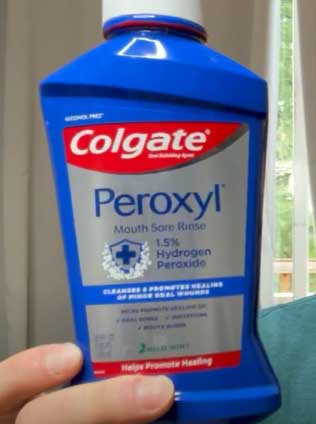
One of the biggest reasons I keep reaching for Colgate Peroxyl is how quickly it works.
Whether it’s a canker sore, a cheek bite, or gum irritation from my new dental aligners, this rinse starts soothing almost immediately.
The hydrogen peroxide creates a gentle fizzing sensation that feels like it’s actively tackling the problem.
In my experience, discomfort drops significantly within a couple of uses, and healing kicks in faster than with other products I’ve tried.
It’s like having a first-aid kit for your mouth.
- Gentle, Alcohol-Free Formula
If you’ve ever used a mouthwash that feels like pouring fire on a wound, you’ll appreciate Peroxyl’s alcohol-free formula. It doesn’t sting or burn, which is a godsend for sensitive mouths. I’ve got a low tolerance for harsh products, so this was a major win.
The mild mint flavor is just strong enough to leave your mouth feeling fresh but not so intense that it overpowers your senses. It’s a perfect balance for daily use without irritation.
- Versatile for Oral Issues
Peroxyl isn’t a one-trick pony. It’s designed to tackle a range of minor oral problems—canker sores, gum inflammation, mouth burns, even irritation from dentures or braces. I’ve used it for everything from post-dental procedure soreness to a random lip burn from hot coffee.
Each time, it delivers consistent relief and promotes healing. It’s like the Swiss Army knife of mouth rinses, making it a versatile addition to any oral care routine.
- Easy to Use and Long-Lasting
The rinse is super straightforward to use—just measure out 10ml, swish for a minute, and spit. No complicated steps or mixing required. The 500ml bottle lasts ages, even with regular use, which makes it a great value.
I’ve been using mine for weeks, and it’s still going strong. Plus, the compact size means it doesn’t hog space, which is a bonus for those of us with limited storage.
Cons of Colgate Peroxyl
- Slightly Dry Aftertaste
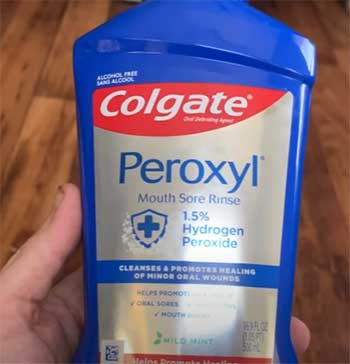
While I love the mild mint flavor, I’ve noticed a slightly dry aftertaste after rinsing.
It’s not a dealbreaker, but it can feel a bit odd, especially if you’re sensitive to mouth dryness.
Drinking water afterward helps, but I wish the formula left a touch more moisture behind.
It’s a small gripe, but worth mentioning if you’re picky about how your mouth feels post-rinse.
- Limited Use Duration
Peroxyl’s instructions are clear: don’t use it for more than seven days unless a dentist or doctor says otherwise. This makes sense since it’s a targeted treatment, not a daily mouthwash, but it can be a bummer if you’re dealing with recurring issues.
I found myself wishing I could keep using it preventatively, but I had to stick to the guidelines to avoid potential overuse.
- Not a Cure-All
While Peroxyl is fantastic for minor oral irritations, it’s not a miracle worker for severe issues. For example, when I had a stubborn cold sore, it helped soothe the area but didn’t fully resolve the problem.
If you’ve got deeper infections or chronic conditions, you’ll need to pair it with professional treatment. It’s a great first step, but don’t expect it to fix everything on its own.
Tips For Using Colgate Peroxyl
- Follow the Dosage Instructions
To get the most out of Peroxyl, stick to the recommended dosage—10ml (two teaspoons) up to four times a day. I learned early on that overdoing it doesn’t speed up healing and can irritate your mouth. Measure it out with the cap or a spoon to be precise.
Swish for at least a minute to let the hydrogen peroxide do its thing, then spit it out. Trust me, consistency with the right amount works better than going overboard.
- Store It Properly
Keep your Peroxyl bottle at room temperature (68-77°F) to maintain its effectiveness. I made the mistake of leaving mine in a steamy bathroom for too long, and I noticed the formula seemed less fizzy over time.
Store it in a cool, dry spot away from direct sunlight or heat sources. Also, make sure the cap is tightly sealed to prevent evaporation or contamination.
- Pair with Good Oral Hygiene
Peroxyl works best when you’re keeping up with your regular oral care. Brush twice a day, floss, and use a gentle toothpaste to complement the rinse.
When my gums were irritated, I found that combining Peroxyl with a soft-bristle toothbrush and a non-irritating toothpaste made a huge difference. It’s like giving your mouth a full support system to heal faster.
- Monitor Your Symptoms
Pay attention to how your mouth feels while using Peroxyl. If your symptoms don’t improve after seven days or you notice swelling, rash, or fever, stop using it and see a dentist or doctor.
I had a minor gum issue that lingered, and checking in with my dentist helped me catch it early. Peroxyl is great, but it’s not a substitute for professional care when things get serious.
- Avoid Swallowing
This one sounds obvious, but it’s worth repeating: don’t swallow Peroxyl. The hydrogen peroxide is safe for rinsing but not for ingesting. If you accidentally swallow a bit, don’t panic—just drink water and contact a doctor if you feel unwell.
I keep a glass of water nearby to rinse my mouth after using Peroxyl, which helps clear any residue and keeps things safe.
How Peroxyl Fits Into Your Routine?
Incorporating Peroxyl into your daily life is a breeze, especially if you’re already diligent about oral hygiene. I like to use it after meals when my mouth feels a bit off, like after eating acidic foods that irritate my gums.
It’s also a great post-brushing rinse if you’ve got a sore or abrasion, as it complements your toothpaste without clashing. Just make sure you’re not using it as a substitute for brushing or flossing—think of it as an extra layer of care for those pesky oral hiccups.
If you’re someone with braces, dentures, or aligners, Peroxyl is especially handy. My aligner-wearing days taught me how quickly irritation can creep up, and having a rinse like this on hand makes all the difference.
It’s also a solid choice for anyone recovering from dental work, like fillings or extractions, where gentle cleansing is key. Basically, if your mouth is throwing a tantrum, Peroxyl is like the calm, cool-headed friend who helps sort it out.
Comparison of Colgate Peroxyl Mouth Sore Rinse With Other Brands
When it comes to choosing a mouth rinse for soothing oral irritations, Colgate Peroxyl stands tall, but how does it stack up against other popular options?
I’ve tried TheraBreath Healthy Gums Oral Rinse, Parodontax Mouthwash, and GuruNanda Mouthwash, and each brings something unique to the table.
Let’s break it down in a head-to-head comparison to see how Peroxyl holds its own against these competitors, focusing on their formulas, effectiveness, taste, and suitability for specific oral issues. Trust me, this will help you decide which rinse is your best bet.
- Colgate Peroxyl Vs. TheraBreath Healthy Gums Oral Rinse
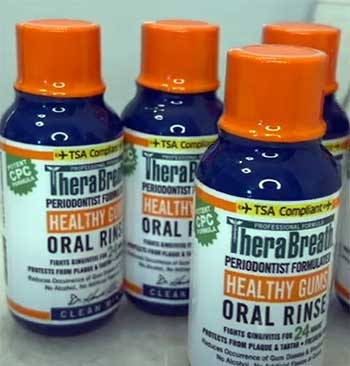
TheraBreath Healthy Gums Oral Rinse caught my attention with its promise of tackling gum issues and bad breath.
Its active ingredient, cetylpyridinium chloride, is great for killing bacteria and keeping your mouth fresh, which I noticed after a few uses—my breath felt clean for hours.
However, when I used it for a canker sore, it didn’t provide the same targeted relief as Peroxyl.
TheraBreath’s formula isn’t designed to cleanse wounds or promote healing like Peroxyl’s 1.5% hydrogen peroxide, which fizzes to remove debris and speed up recovery.
Taste-wise, TheraBreath’s neutral, slightly sweet flavor is pleasant but lacks the refreshing minty zing of Peroxyl. For minor oral wounds or post-dental irritation, Peroxyl’s oxygenating action gives it a clear edge.
TheraBreath is better suited for daily gum maintenance and breath freshening, but it falls short when you need a rinse to heal specific sores.
- Colgate Peroxyl Vs. Parodontax Mouthwash
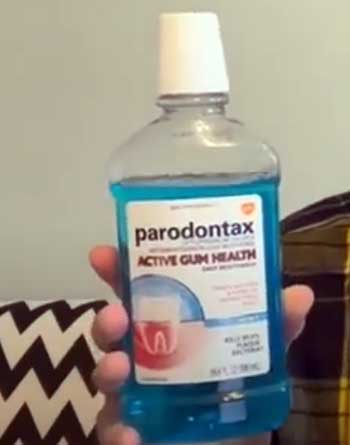
Parodontax Mouthwash is a go-to for many dealing with gum issues, especially gingivitis, thanks to its chlorhexidine gluconate formula.
I tried it when my gums were inflamed after a deep cleaning, and it did reduce bacterial buildup and calm things down over time.
But here’s the catch: Parodontax isn’t tailored for healing mouth sores or irritations like Peroxyl.
When I had a cheek bite, Parodontax helped with general oral hygiene but didn’t soothe the wound or promote healing the way Peroxyl’s hydrogen peroxide did.
The taste of Parodontax is another hurdle—it’s medicinal and slightly bitter, which made rinsing less enjoyable compared to Peroxyl’s mild mint flavor. Plus, Parodontax can stain teeth with prolonged use, something I never worried about with Peroxyl.
If your primary concern is gum disease, Parodontax might be your pick, but for versatile relief from sores and minor wounds, Peroxyl wins hands-down.
- Colgate Peroxyl Vs. GuruNanda Mouthwash
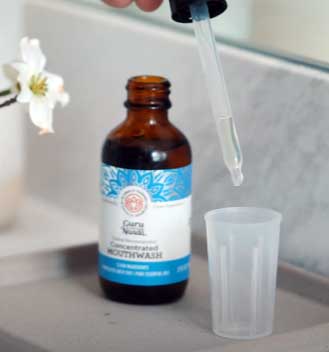
GuruNanda Mouthwash, with its coconut oil and essential oil blend, intrigued me as a natural alternative.
I gave it a whirl for overall oral health, and it left my mouth feeling clean and moisturized, thanks to the oil-pulling-inspired formula.
The peppermint and clove flavors were bold and refreshing, though a bit intense compared to Peroxyl’s subtler mint.
However, when I used GuruNanda for gum irritation from my aligners, it didn’t deliver the same healing punch as Peroxyl.
GuruNanda’s focus is on detoxifying and freshening, not wound cleansing or soothing inflammation, so it couldn’t match Peroxyl’s ability to tackle sores or post-dental tenderness. I also found GuruNanda’s oily texture less practical for quick rinsing—Peroxyl’s straightforward swish-and-spit is much easier.
If you’re into natural remedies and want a rinse for daily freshness, GuruNanda’s a solid choice, but for targeted relief of oral irritations, Peroxyl’s hydrogen peroxide formula takes the crown.
Why Peroxyl Stands Out in the Lineup?
Across these comparisons, Peroxyl consistently shines for its specialized approach to healing minor oral wounds. Unlike TheraBreath’s broad-spectrum bacterial control, Parodontax’s gum-disease focus, or GuruNanda’s natural detox vibe, Peroxyl hones in on soothing and repairing sores, burns, and irritations with its oxygenating action.
The alcohol-free formula and gentle mint flavor make it a joy to use, especially for sensitive mouths like mine. While each competitor has its strengths—TheraBreath for breath, Parodontax for gums, GuruNanda for natural care—none match Peroxyl’s versatility and effectiveness for acute oral issues.
If you’re dealing with a specific sore or irritation, Peroxyl’s your best friend; for general maintenance, you might lean toward one of the others.
Frequently Asked Questions (FAQ)
You shouldn’t use Peroxyl for more than seven days unless a dentist or doctor advises otherwise. It’s also not suitable for children under two without professional guidance. If you have severe oral issues like deep infections or persistent symptoms, skip Peroxyl and seek medical advice. I learned this the hard way when a stubborn sore didn’t budge—my dentist pointed out that Peroxyl is for minor issues, not major ones. Always check with a pro if you’re unsure.
Yes, Peroxyl works wonders for minor oral irritations. In my experience, it reduced soreness and sped up healing for canker sores and gum inflammation within days. The hydrogen peroxide cleanses wounds and removes debris, which helps your mouth heal faster. That said, it’s not a cure for serious conditions, so manage expectations. For everyday sores or post-dental tenderness, it’s been a reliable fix for me and countless others.
Peroxyl is generally safe, but side effects can include temporary dryness or a weird aftertaste, which I’ve noticed occasionally. In rare cases, you might experience irritation, redness, swelling, rash, or fever—if these happen, stop using it and see a doctor. Swallowing large amounts can upset your stomach, so always spit it out. I’ve never had major issues, but keeping an eye on how your mouth feels is key.
Peroxyl isn’t meant for daily, long-term use. The instructions say to use it up to four times a day for no more than seven days unless a dentist says otherwise. I’ve used it short-term for specific issues, but for everyday oral care, I switch to a regular mouthwash or toothpaste. Overusing hydrogen peroxide can irritate your mouth, so stick to the guidelines to keep things safe and effective.
Wrapping Up
Colgate Peroxyl Mouth Sore Rinse is your go-to for tackling mouth sores, gum irritation, and minor oral wounds. Its gentle, alcohol-free formula and powerful hydrogen peroxide action deliver fast relief and promote healing, all with a pleasant minty flavor.
I’ve shared my journey, pros, cons, and tips to help you make the most of it. Trust me, this rinse is a must-have for anyone seeking a soothing, effective solution. Pick up Peroxyl today and experience the difference it can make in your oral care routine!
